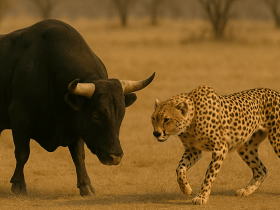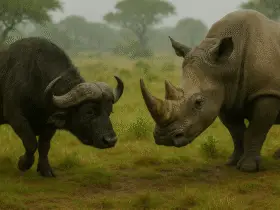What happens if two of heavyweights creatures of the animal world—hippo vs bull engaged to a faced to face fight? On one side, we have the bull, strong and muscular, known for its powerful charge and those sharp, curved horns. On the other, the hippo, a seemingly slow giant that actually ranks among the most dangerous animals in Africa.
It may look chubby and calm, but with massive jaws and a serious temper, the hippo is no joke. While they live in different habitats, imagining a face-off between these two is both fun and fascinating.
Let’s explore how the land-loving bull and the water-loving hippo compare in strength, defense, and attitude. Here we have bought you the well researched scientific data by categorizing each feature about Hippo vs Bull . Hope you will enjoy!
1. Body Specifications
| Subtopic | Hippo | Bull | Winner |
|---|---|---|---|
| Average Weight | 1,400–1,800 kg (males) | 500–1,100 kg (depending on breed) | Hippo |
| Height at Shoulder | 1.5 m | 1.4–1.6 m | Draw |
| Body Length | 3.3–5.0 m | 2.0–3.0 m | Hippo |
| Skull Size | Massive, 60–70 cm long | Moderate | Hippo |
| Muscle Mass | High, especially jaw and neck | High – powerful forequarters | Draw |
| Bone Density | Extremely dense bones for buoyancy | Dense – built for impact | Hippo |
| Horn Size/Shape | N/A (has tusks instead) | Long, sharp horns in some breeds | Bull |
| Fat Composition | Thick subcutaneous fat | Moderate – varies by breed | Hippo |
| Body Shape | Barrel-shaped for water buoyancy | Compact, muscular | Draw |
| Combat Anatomy | Huge jaw and tusks | Horns and powerful shoulders | Hippo |
Category Winner: Hippo – Overwhelms in size and bone density.
2. Skin, Coat, and Coloration
| Subtopic | Hippo | Bull | Winner |
|---|---|---|---|
| Skin Thickness | Up to 6 cm thick | Moderate | Hippo |
| Coat Type | Nearly hairless | Short fur coat | Bull |
| Skin Color | Greyish-brown | Varies: black, brown, white, spotted | Draw |
| UV Protection | Produces red sweat (natural sunscreen) | Needs shade or shelter | Hippo |
| Waterproofing | Excellent – aquatic skin | Poor – not adapted for water | Hippo |
| Parasite Resistance | Moderate | Moderate to low | Draw |
| Healing Ability | Fast – wounds heal quickly underwater | Moderate | Hippo |
| Melanin Presence | Low | Moderate to high | Bull |
| Coat Camouflage | Not needed | Some breeds are well camouflaged | Bull |
| Abrasion Resistance | Very high – skin like armor | Moderate | Hippo |
Category Winner: Hippo – Skin is virtually impenetrable in battle.
3. Habitat and Range – Hippo vs Bull
| Subtopic | Hippo | Bull | Winner |
|---|---|---|---|
| Native Range | Sub-Saharan Africa | Global (domesticated) | Bull |
| Preferred Habitat | Rivers, lakes, swamps | Plains, farms, ranches | Draw |
| Climate Preference | Warm, humid | Wide range – adaptable | Bull |
| Altitude Tolerance | Lowland dwellers | High tolerance | Bull |
| Water Dependence | Extremely dependent on water | Independent | Bull |
| Land Movement | Limited to feeding at night | Fully mobile on land | Bull |
| Territorial Nature | Extremely territorial in water | Males can be territorial | Hippo |
| Population Density | Patchy – near water bodies only | Very high | Bull |
| Urban Adaptability | None | Moderate (rural to urban transition possible) | Bull |
| Seasonal Behavior | Stays in water during dry season | Grazes all year | Bull |
Category Winner: Bull – Wins by adaptability and global distribution.
4. Diet and Feeding Behavior
| Subtopic | Hippo | Bull | Winner |
|---|---|---|---|
| Diet Type | Herbivore (grazes at night) | Herbivore (grazes and chews cud) | Draw |
| Daily Food Intake | 35–40 kg grass | 10–20 kg grass + feed | Hippo |
| Feeding Duration | 4–6 hours per night | Several grazing sessions per day | Draw |
| Jaw Movement | Wide – 150° gape | Side-to-side chewing | Hippo |
| Digestive System | Non-ruminant | Ruminant (4-chamber stomach) | Bull |
| Energy Storage | Stores fat under skin | Stores in muscles and fat | Draw |
| Foraging Distance | Up to 5 km nightly | Variable – depends on pasture | Draw |
| Competition for Food | Low | Managed or controlled | Bull |
| Defensive Feeding | Aggressive if approached | Passive | Hippo |
| Water Source Use | Spends most day submerged | Drinks and leaves | Hippo |
Category Winner: Hippo – More dominant and aggressive during feeding.
5. Strength and Bite Force
| Subtopic | Hippo | Bull | Winner |
|---|---|---|---|
| Bite Force (PSI) | 1,800–2,000 PSI | ~800 PSI (limited) | Hippo |
| Lifting Power | N/A | Can lift or push up to 1,200 kg | Bull |
| Impact Force | Massive head slams, tusk goring | Powerful horn ramming | Draw |
| Jaw Size | Enormous – can open 150 degrees | Normal mammalian jaw | Hippo |
| Neck Strength | Immense – supports heavy skull | Very high | Draw |
| Tusk/Horn Strength | 30–50 cm long canines | Horns vary by breed | Hippo |
| Headbutting Ability | Poor – used jaws, not heads | Excellent | Bull |
| Durability in Fight | Very high | High – depending on breed | Hippo |
| Crushing Capability | Can bite a crocodile in half | Cannot crush, but can stab | Hippo |
| Muscle-to-Weight Ratio | Moderate | Very high | Bull |
Category Winner: Hippo – Dominates in bite force and crushing power.
6. Speed and Agility – Hippo vs Bull
| Subtopic | Hippo | Bull | Winner |
|---|---|---|---|
| Top Speed (Land) | Up to 30 km/h | Up to 40 km/h | Bull |
| Acceleration | Moderate – slow starter | Fast sprinter on short bursts | Bull |
| Turning Agility | Poor – bulky and heavy | High – agile on land | Bull |
| Swimming Speed | ~8 km/h (can trot underwater) | Poor swimmer | Hippo |
| Jumping Ability | Cannot jump | Some bulls can jump low fences | Bull |
| Climbing Ability | None | Limited – depends on terrain | Bull |
| Balance | Stable in water | Balanced on uneven terrain | Bull |
| Stamina | Low endurance – overheats quickly | High stamina in pasture conditions | Bull |
| Reaction Time | Slow | Faster reflexes | Bull |
| Agility in Tight Space | Poor | Good – especially in barns/corrals | Bull |
Category Winner: Bull – Strong advantage on land in terms of speed and agility.
7. Senses
| Subtopic | Hippo | Bull | Winner |
|---|---|---|---|
| Vision | Poor out of water, better in water | Moderate – decent eyesight | Bull |
| Hearing | Moderate | Good hearing – responds to subtle sounds | Bull |
| Smell | Very strong – helps with territory marking | Excellent – used in mating and detection | Bull |
| Night Vision | Moderate | Good | Bull |
| Peripheral Vision | Eyes on sides of head, 150°–180° range | Similar lateral vision | Draw |
| Sensory Whiskers | Lacks prominent whiskers | Absent | Draw |
| Vibration Detection | Senses water movement | Senses ground vibration | Draw |
| Communication Sounds | Grunts, bellows, underwater calls | Bellows, snorts, and roars | Draw |
| Sensory Priority | Smell over sight | Smell and hearing balanced | Bull |
| Overall Awareness | Low alertness on land | Higher alertness overall | Bull |
Category Winner: Bull – Superior sensory awareness on land.
8. Reproduction and Lifespan
| Subtopic | Hippo | Bull | Winner |
|---|---|---|---|
| Sexual Maturity Age | 5–7 years | 1–2 years | Bull |
| Gestation Period | 8 months | 9 months (for cows) | Draw |
| Litter Size | 1 calf | 1 calf | Draw |
| Mating Behavior | Aggressive in water | Competitive among bulls | Draw |
| Calf Survival Rate | Moderate – risks from crocs and lions | High – protected by humans | Bull |
| Lifespan (Wild) | 40–50 years | 15–20 years | Hippo |
| Lifespan (Captivity) | Similar – up to 50 years | Up to 25 years | Hippo |
| Parental Care | Mother defends calf fiercely | None – only cows care for calves | Hippo |
| Mating Rights | Dominance-based | Human-controlled or dominance-based | Draw |
| Reproductive Output | Slow – 1 calf every 2 years | Higher – more frequent matings | Bull |
Category Winner: Draw – Each excels in different reproductive aspects.
9. Social Behavior
| Subtopic | Hippo | Bull | Winner |
|---|---|---|---|
| Social Structure | Semi-social pods with hierarchy | Solitary or part of herd | Draw |
| Territoriality | Highly territorial, especially in water | Males can be territorial | Hippo |
| Aggression Level | Extremely aggressive | Aggressive, especially during rut | Hippo |
| Interaction with Others | Tolerant in groups, but unpredictable | Limited – mostly dominant behavior | Hippo |
| Mating Competition | Violent clashes between males | Can be aggressive toward other bulls | Draw |
| Herd Size | 10–30 individuals | Varies widely – often large herds | Bull |
| Communication | Grunts, bellows, snorts | Roars, grunts, head gestures | Draw |
| Defense of Young | Fierce mother defense | Not applicable to males | Hippo |
| Cooperation Level | Low | Low | Draw |
| Tolerance of Humans | Low | High – domesticated | Bull |
Category Winner: Hippo – Stronger territoriality and defensive aggression.
10. Conservation Status
| Subtopic | Hippo | Bull | Winner |
|---|---|---|---|
| IUCN Status | Vulnerable | Not listed (domesticated species) | Bull |
| Population Trend | Decreasing | Stable or increasing | Bull |
| Threats | Habitat loss, poaching | None (farm management) | Bull |
| Legal Protection | Yes – CITES Appendix II | N/A | Hippo |
| Conservation Efforts | Active programs | Not needed | Bull |
| Global Population | ~115,000 wild | Over 1 billion | Bull |
| Captive Breeding | In zoos, with low success | Standard on farms | Bull |
| Ecological Impact | Maintains aquatic ecosystems | Agricultural livestock | Hippo |
| Human Conflict | High – attacks boats, fishermen | Low | Bull |
| Cultural Significance | Revered and feared in Africa | Domesticated, symbolic in many cultures | Draw |
Category Winner: Bull – Thrives due to domestication and global management.
Interesting Facts – hippo vs bull
Bulls
-
Bulls can sense emotions through pheromones and body language.
-
Their horns grow continuously and are used for fighting and digging.
-
Some breeds are specially bred for aggression, like the Spanish Fighting Bull.
-
Bulls can charge at speeds up to 25 mph.
-
Strong neck muscles help deliver powerful headbutts.
Hippos
-
Hippos secrete a red oily substance that acts as sunscreen and antibacterial lotion.
-
They can run up to 19 mph on land and hold their breath underwater for 5 minutes.
-
Hippos communicate with unique sounds both above and below water.
-
Baby hippos nurse underwater, closing ears and nostrils.
-
Their dung fertilizes aquatic ecosystems, supporting fish and plants.
Face-to-Face Fight Analysis: Hippo vs Bull
In a direct one-on-one fight, the hippo holds nearly every physical advantage:
- Crushing bite force (~2,000 PSI) can break bones instantly.
- Massive body weight (up to 1,800 kg) gives it unmatched momentum.
- 4 tusk-like canines (30–50 cm long) can pierce a bull’s body easily.
- Highly aggressive behavior means the hippo strikes first and without hesitation.
While the bull has strong horns, speed, and land agility, it simply cannot match the hippo’s bulk or weaponry. The bull may land a charge or two, but it lacks the stamina and jaw force to inflict serious damage on a creature as armored and resilient as a hippo.
In water or near a riverbank, the bull would be at an even greater disadvantage.
Winner in a Fight: HIPPO
- National Geographic – Hippopotamus Profile
https://www.nationalgeographic.com/animals/mammals/facts/hippopotamus - BBC Earth – The Secret Life of Hippos
https://www.bbcearth.com/news/the-secret-life-of-hippos - Animal Diversity Web – Bos taurus (Bull) Facts
https://animaldiversity.org/accounts/Bos_taurus/ - San Diego Zoo – Hippopotamus
https://animals.sandiegozoo.org/animals/hippopotamus - FAO – The State of the World’s Animal Genetic Resources
https://www.fao.org/3/a1250e/annexes/Thematic%20studies/T1/T1.pdf
Read More – Rhino vs Gorilla : A Comprehensive Comparison






Leave a Reply